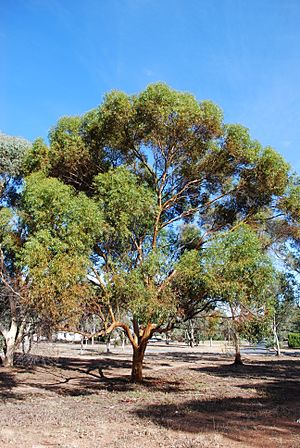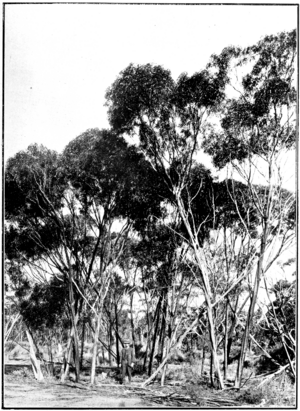Gimlet facts for kids
Quick facts for kids Gimlet |
|
|---|---|
 |
|
| Scientific classification | |
| Genus: |
Eucalyptus
|
| Species: |
salubris
|
The Gimlet (scientific name: Eucalyptus salubris) is a special kind of Eucalyptus tree. People also call it the fluted gum tree, gimlet gum, or silver-topped gimlet. It's a type of tree called a mallet, which means it usually grows with a single, strong trunk and doesn't have a big woody base at the ground. This tree is found only in the dry areas of the Wheatbelt and Goldfields regions of Western Australia.
Contents
What the Gimlet Tree Looks Like
The Gimlet tree usually grows between 4 and 15 meters (about 13 to 49 feet) tall. Sometimes it can be as short as 2 meters (6.5 feet) or as tall as 24 meters (79 feet). It has smooth, shiny trunks and branches that look like they've been twisted or fluted. This is why it's called a "gimlet," like the tool used for drilling holes!
The Gimlet tree blooms with white or cream-colored flowers from September to March. Its leaves are a glossy green color on both sides. They are narrow and shaped like a spear, usually about 6.5 to 10.5 centimeters (2.5 to 4 inches) long.
The flowers grow in groups of seven. After the flowers, the tree produces fruit that are shaped like a half-sphere or a cone. These fruits are about 0.5 to 0.7 centimeters (0.2 to 0.3 inches) wide. The seed capsules stay on the tree until the next spring. Each gram of these capsules can hold about 400 tiny seeds!
How the Gimlet Tree Got Its Name
The Gimlet tree was first officially described in 1876 by a scientist named Ferdinand von Mueller. He studied samples collected by Jess Young during an expedition in May 1875.
The scientific name salubris comes from a Latin word. It means "healthful" or "beneficial." This name was chosen because the tree looked very healthy and strong. The common name "gimlet" refers to its unique, twisted trunks. They look a lot like a carpenter's gimlet, which is a tool used to bore holes.
The Gimlet tree is part of a special group of nine "true gimlet" species. These trees are known for their slender, twisted, and shiny trunks. The Eucalyptus salubris is the only one in this group that grows as a mallet.
Where the Gimlet Tree Grows
The Gimlet tree is found in many places across Western Australia. You can see it in the Avon Wheatbelt and Coolgardie areas. It can even be found as far west as Perth and as far south as Esperance.
This tree can grow in different types of soil, including red loams, red clay loams, and sandy soils. It is very common in the Wheatbelt and the southern part of the Goldfields-Esperance regions. Its range stretches from Mullewa in the northwest all the way to Pingrup in the southeast. It also extends east to Norseman and Zanthus, and north to Laverton.
Uses of the Gimlet Tree
The Gimlet tree is useful for many things! Its strong wood is used to make fence posts. Because it looks so nice, it's also planted as an ornamental tree in gardens. Farmers often use it as a shelterbelt or shade tree for their animals.
The flowers of the Gimlet tree produce a lot of nectar, which is great for making honey. The pollen is also valuable for beekeeping. The bark of the tree has a high amount of tannin, a substance used in many industries.
This tree is very tough. It can handle both frost and drought, which means it can grow in many parts of the world. However, in Western Australia, many large groups of Gimlet trees have been cleared to make space for farmland. This is because they prefer rich, loamy soils, which are also good for farming.



